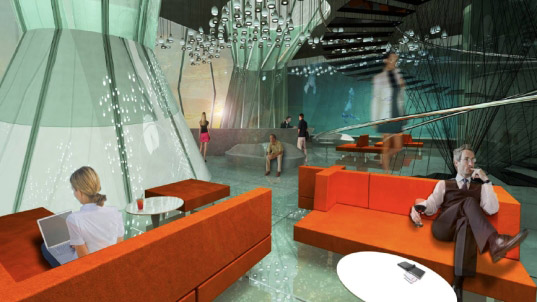Morris Architects, a Houston-based architecture and design firm, recently took top honors for two of their submissions in the
Radical Innovation in Hospitality design competition. The grand prize winner, the
Oil Rig Platform Resort and Spa makes use of one of 4,000 oil rigs out in the Gulf of Mexico and transforms it into a luxurious
eco-resort
and spa. We love how the inspired renovation takes an iconic source of
dirty energy and converts it to an eco-haven that generates all of its
power from
renewable sources.
Sponsored by the
John Hardy Group and
Hospitality Design Magazine, the international design competition focused on innovations in hospitality. The
Morris
design team wanted to take advantage of the an abandoned oil rig in the
Gulf of Mexico and reuse the structure, transforming it into a vibrant
and commercially viable destination. The luxury resort offers many
amenities including interaction with the surrounding ocean - boating,
snorkeling, diving and other water sports. The Rig Hotel will also draw
in conferences and business meetings, and will serve as a cruise ship’s
main port of call en route to other locations in Mexico and the
Caribbean.
Situated in the middle of the ocean, the Rig Hotel will need to be as
autonomous as possible, generating all of it’s own power from renewable energy, most notably via a large
vertical axis wind turbine
affixed to one of its foundation towers. Wind power tends to be far
more efficient off-shore than on-shore, and the turbine will meet a
significant portion of the Rig’s energy demands.
Wave energy generators
will be buoyed nearby with undersea cables to transmit the power. Solar
panels will be affixed on the sides and top of the rig. Additionally,
geothermal heat pumps
will take advantage of the consistent water temperatures at lower sea
levels to aid with heating and cooling of the interior rooms. All of
these power systems can easily be integrated into the existing rig
infrastructure.
The Oil Rig Resort and Spa will provide unparalleled views of the Gulf
through patron’s rooms as well as a glass lobby floor. The lobby will
be naturally lit with ambient light, which will be reflect the ocean. A
central core will be filled with water, which acts as a ballast to help
stabilize the platform during stormy conditions. This central core will
also host theatrical performances much like the
Cirque du Soliel show ‘O’ in Las Vegas. Guests will be able to view the show from their own room every night.
Individual guest rooms are prefabricated off site and transported via
ship in a standard cargo container to the rig. The rooms are not large
and have been optimized to maximize space. Couches turn into beds at
night and can be moved over the hot tub for viewing of performances.
The room can also extend out over the water for better views of the
Gulf. The
eco-resort
provides a state-of-the-art luxury accomodations, as well as sea-water
swimming facilities, a grand ballroom shopping, dining, nightly
entertainment, a casino, and boat slips. And considering that there are
over 4,000 oil platforms out there in the Gulf, it’s certainly a novel
way to reuse the existing structures.
from inhabitat







